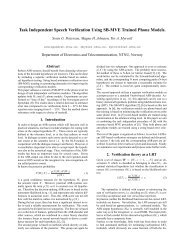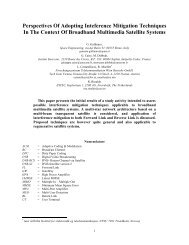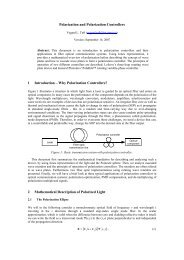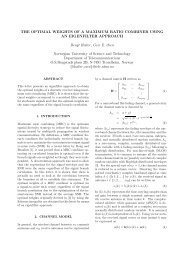Lab 4 Laser - Institutt for elektronikk og telekommunikasjon - NTNU
Lab 4 Laser - Institutt for elektronikk og telekommunikasjon - NTNU
Lab 4 Laser - Institutt for elektronikk og telekommunikasjon - NTNU
Create successful ePaper yourself
Turn your PDF publications into a flip-book with our unique Google optimized e-Paper software.
Chapter 1<br />
<strong>Lab</strong> exercise:<br />
From pink light to red LASER<br />
This lab exercise gives insight into the fundamentals of laser operation. A<br />
HeNe-discharge tube is used and aligned with a mirror to construct a laser.<br />
The fundamental properties of this laser are then investigated.<br />
1.1 <strong>Laser</strong> safety<br />
A laser can be a powerful and harmful device. It is there<strong>for</strong>e very important<br />
that the laser is handled with outmost care and that your eyes always are<br />
protected. Never look into the laser aperture nor into the reflected light from<br />
the brewster window.<br />
1.1.1 Electrical hazard<br />
The HeNe laser is pumped with a very high voltage: 1900 Volts!! There<strong>for</strong>e:<br />
Do not touch any connectors on the HeNe discharge tube. The PSU (power<br />
supply unit) feeds the tube with 7mA. This is enough to kill you if you touch<br />
both wires!! There<strong>for</strong>e, again: Do not tamper with any of the electrical wires<br />
concerning the discharge tube!<br />
1.1.2 Light hazard<br />
Do NOT stare into laser light!!<br />
This is the first and most important rule <strong>for</strong> operating lasers. A laser provides<br />
high intensity light and may just burn a hole in your retina if you look into the<br />
laser light.<br />
Since the first laser was made in 1960 it has been clear that laser emissions<br />
are a hazard to the eye and skin, more of a hazard than most other light<br />
sources. <strong>Laser</strong>s are hazardous because they produce intense directed energy<br />
that can damage living tissues. There are other common light sources strong<br />
enough to cause permanent eye or skin damage, including: direct sunlight, arc<br />
3
















